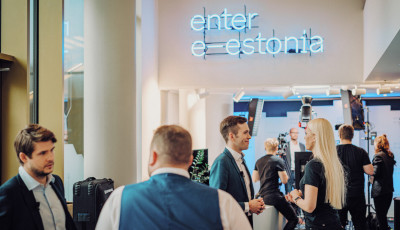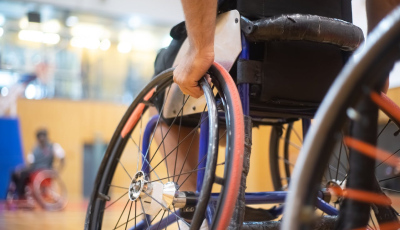Executive summary
The Estonian State Portal, eesti.ee, is a secure gateway that offers a single digital service platform, integrating and managing official information and personalized e-services for both citizens and entrepreneurs. The portal is overseen by the Information System Authority (RIA), which serves as a national competence center responsible for shaping and securing the foundations of Estonia’s digital society.
As part of a broader modernization project, RIA aimed to migrate the State Portal to a micro-frontend architecture, improving its maintenance and facilitating the integration of services provided by different institutions. Helmes won the tender to deliver this solution, and the first phase of the project was completed in August 2024.
Micro-frontend architecture involves breaking a frontend application into smaller, autonomous modules known as micro frontends (MFEs). These MFEs can be developed in isolation, modified without impacting the rest of the application, and reused in other applications.
The Estonian State Portal includes two separate sections: the Portal for Citizens and the Portal for Entrepreneurs. Initially, they were distinct applications with significant code duplication. As part of the project, we combined the two portals into a single shell application. This structure allows us to add business functionalities can be added as micro frontends, enhancing overall efficiency.
We broke down the monolith architecture and migrated existing business functionalities to micro frontends (MFEs). Additionally, we created some new MFEs and made several other improvements, such as developing reusable components based on the Veera style book and integrating the State Portal with the new central authorizations management information system, Pääsuke.
As a result of the project, maintaining and updating the State Portal has become much more manageable. Now, any change only needs to be implemented just once in the corresponding MFE. This improvement allows other institutions to take full ownership of their services, making it simpler for them to offer their services on the State Portal with reduced development effort. Additionally, institutions can utilize MFEs from the State Portal within their own systems without the need to develop services from scratch. The MFE architecture also makes it easier to add services to the State Portal, which means that citizens and entrepreneurs will benefit from access to a broader range of e-services in the future.
Continue reading the case study to see how the micro-frontend architecture facilitates the delivery of state e-services and helps achieve the vision of the State Portal.
Meet the customer
The Information System Authority (RIA) is a national competence center in Estonia responsible for coordinating the development and administration of information systems. Its main goals are to ensure the interoperability of the state’s information systems, organize activities related to information security, and handle security incidents within Estonian computer networks.
RIA also oversees the State Portal eesti.ee, which serves as a secure gateway to the state’s e-services and information for both citizens and entrepreneurs. Through this portal, Estonian residents can access information about various life events, view their personal data, and utilize a range of state-provided e-services, including those related to businesses.
RIA has begun the technological modernization of the State Portal, a process that will unfold in several phases. The first step involved migrating the State Portal to a micro-frontend architecture. This initial phase of the project was completed in August 2024 in collaboration with their development partner, Helmes.
Challenge
The State Portal aims to provide citizens and entrepreneurs with convenient access to reliable information, contact details, and all the available state e-services in a secure environment. The services offered include everything from the user’s medical prescriptions and traffic insurance history to an entrepreneur’s dashboard.
Over the years, the State Portal has expanded to include 10 different applications, leading to significant code duplication. This has made maintenance and updates increasingly challenging.
To enhance the benefits for citizens and entrepreneurs, RIA aimed to simplify the process of adding and managing services on the portal, as a broad spectrum of institutions provide these. Migrating the State Portal to the micro-frontend architecture was identified as the most effective solution to achieve these objectives.
Solution
Micro-frontend architecture is implemented by breaking down a frontend application into smaller, autonomous modules – an approach to building applications that is roughly equivalent to microservices in the backend. These modules, or micro frontends (MFEs), can be built in isolation by different teams, easily modified without affecting the rest of the system, and reused in other applications.
Migrating the State Portal to the micro-frontend architecture was executed in several stages.
1. We created a shell application to support micro frontends.
The State Portal consists of two distinct sections: the Portal for Citizens and the Portal for Entrepreneurs. Previously, these were separate applications with significant code duplication.
We combined the two portals into a single shell application, where MFEs can be integrated. You could think of the shell application as a puzzle board and MFEs as puzzle pieces that can be fitted into it.
Although both portals are now contained within a single shell application, they still appear as two portals to users. This integration makes the State Portal’s maintenance considerably more manageable. For example, if we need to update the component that displays articles, a change made to the MFE will automatically be reflected in both portals. Previously, such updates had to be implemented separately for each portal.
2. We migrated existing business functionalities to micro frontends and created some new ones.
Next, we migrated existing business functionalities to micro frontends and created some new ones as well. Unlike a monolith system, these micro frontends can be easily modified and deployed without impacting the shell application. Additionally, they can be easily reused by RIA and other institutions.
We also created guidelines that outline the technical requirements for MFEs aimed at institutions seeking to make their services available on the State Portal.
3. In addition to migration to MFEs, we implemented several other changes.
Based on the Veera style book, we created reusable components that RIA and other institutions can utilize.
The Veera design system serves as a framework for building state e-services in Estonia, aiming to standardize user experience across different state systems while reducing development time and costs.
We also integrated the State Portal with the new central authorizations management information system, Pääsuke, to simplify the process for company representatives in authorizing access to various authorities’ self-service environments.
Benefits
Upgrading the State Portal to a micro-frontend architecture offers numerous benefits for RIA, partner institutions, and users.
- Easier maintenance – By combining the Portal for Citizens and the Portal for Entrepreneurs, maintaining and updating the State Portal becomes more straightforward, as any changes only need to be made once. Moreover, micro frontends allow applications to be version-agnostic, which significantly simplifies component management and enhances decoupling.
- Improved service integration for partners – Thanks to the MFE framework, institutions can now seamlessly offer their services on the State Portal with less development effort and reduced costs. They can either integrate existing services with minimal additional development or create new services without the need to build their own portal.
- Access to private service providers – The upgrade introduces the potential for private organizations to integrate their services into the State Portal, a possibility that was previously unavailable.
- Reuse of services in other systems – Other institutions can easily integrate MFEs from the State Portal, such as the national mailbox, into their systems without having to develop the services themselves.
- Lower development costs – The simpler integration and maintenance of services, along with the possibility of reusing MFEs, significantly reduce the need for development services. This leads to lower development costs for RIA and partner institutions.
- More e-services for citizens and entrepreneurs – The MFE architecture makes it easier to add new services to the State Portal. As a result, citizens and entrepreneurs will gain access to a broader variety of e-services in the future, in accordance with the vision for the State Portal.
Innovating state e-services in collaboration
The project was completed in just over one year and delivered in August 2024. The Helmes team consisted of an architect, two analysts, four developers, a tester, and a project lead.
The project serves as a prime example of innovating state e-services through collaboration with private software development houses. The client identified a problem and set clear objectives while allowing Helmes, its chosen development partner, the freedom to innovate and propose a technological solution.
The MFE technology used in this project represents a relatively new approach to building large-scale applications. It provided our team with a valuable opportunity to gain first-hand experience with the technology and contribute significantly to the advancement of state e-services.
In the next two years, Helmes will continue to modernize the state portal. Our efforts will focus on implementing dynamically configurable micro-frontend components, enabling the client to have complete control of the portal’s content. This approach allows for the seamless addition and removal of components without requiring deployments. Additionally, we will develop a new dashboard tailored to key services for business representatives and integrate more external services into the platform, utilizing the MFE paradigm to enhance flexibility and scalability.
Work with us
Choosing a micro-frontend architecture can be an effective solution when managing a single monolithic frontend module becomes impractical, especially when the system integrates services developed by different teams or service providers.
Helmes has more than 30 years of experience in developing national IT systems and state e-services. If you would like to learn more about our projects or discuss how we could help your organization, please don’t hesitate to contact us.
Get in touch





